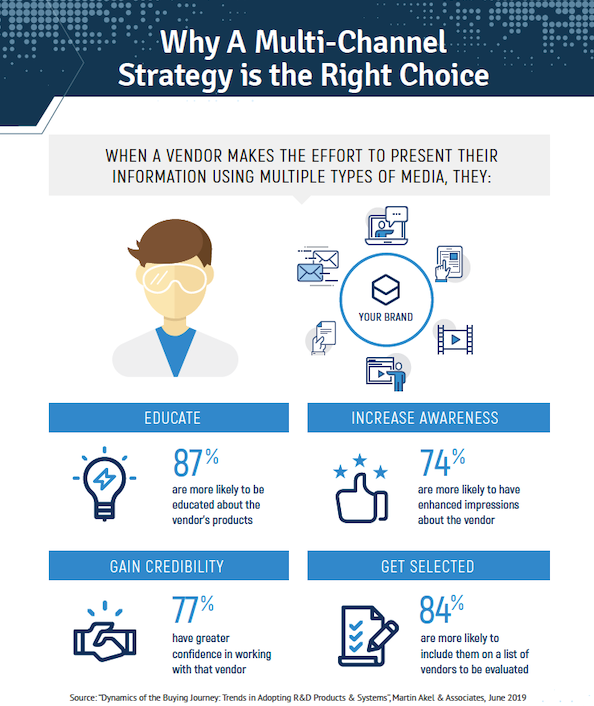The beginning of a new year is a time of setting new marketing expectations, launching new programs, and getting off to a strong start.
Let’s face it: 2020 was a big challenge. But in competitive markets, where buyers are exposed to a wide variety of vendors to choose from, every year presents new challenges for marketers. We always have to be on top of our game: aligning our marketing goals with our resources, choosing the best channels, crafting the right messages, managing data, tracking results.
2021 is no different—and the ongoing COVID-19 pandemic and unsettled markets present even more challenges for marketers trying to start strong.
The best marketing approach during uncertain times is not to react impulsively, but to maintain steadiness and balance. Finding the optimal balance between the two key marketing goals of demand generation and increasing brand visibility can keep you on the right path.
This shouldn’t come as a surprise. Year over year, marketers state their two primary goals are generating leads and increasing brand awareness. And while both branding and demand generation work in tandem as part of your complete marketing strategy, they perform different functions and have different attributes.
Short-Term Demand Generation
Demand generation typically runs in short-term cycles. Marketers plan targeted lead-generation campaigns that run for a set period, perhaps a few months or a fiscal quarter. Demand-generation campaigns feature messaging for a specific audience around solving a specific challenge.
If your company is facing economic pressure in 2021, you might be inclined to lean more toward demand generation and away from branding in hopes of spurring short-term revenue growth. But this might not produce better results. If short-term demand for products and services are depressed during the pandemic and amid economic uncertainty, no amount of demand-generation effort can change that reality.
Another reason not to get away from branding is this: Without the support of branding efforts to keep your name top of mind with potential customers, demand-generation programs are forced to perform too much work in getting through to customers, unless your company is a household name in the life sciences sector.
Long-Term Brand Building
B2B organizations allocate an average of 45 percent of their marketing budgets to branding, according to research conducted by LinkedIn. We recommend you maintain a similar balance during 2021.
Branding, in contrast to demand generation, is a longer game, with campaigns typically lasting six months or more and is best executed using a multi-challenge approach within the same media brand. Campaign goals are to increase your company’s visibility in the market and to lay the groundwork for future business opportunities.
Branding is an essential component of an overall effective marketing strategy, and it can boost demand-generation programs by:
- Making customers familiar with your company name and brand. Customers prefer to buy from brands they know and trust, so they are more likely to respond to your demand-generation campaigns if they recognize your company and what you stand for.
- A better-known brand can command a premium price because buyers are willing to pay more for brands they believe in.
- Branding campaigns can help shorten the sales cycle of demand-generation campaigns because customers already have a positive impression of your brand and salespeople don’t have to start from the very beginning explaining what your company is about.
- Branding campaigns tend to have a broader reach than demand-generation campaigns. You are able to reach beyond your own base and find new contacts and establish new connections, which is a key to new growth.
- Employ a multi-channel approach, using a select few media brands. Effective branding requires consistency and message frequency to the same audience. Pick a few media brands and use several of the channels they offer, over a course of at least three to six months, to make the most impact.

Combining Demand Generation and Brand Building
Branding and demand generation need to work in tandem. One way to do this is to use integrated programs and channels that have elements of both branding and demand generation.
For example, you can engage in an e-newsletter advertising campaign where you mix in a couple of different ads, one higher-level and focused on branding, and the other including a targeted offer to support demand generation. The ads should carry a similar look and feel to reinforce and unify your presence in the market.
Another example is to maintain an ongoing presence in the Biocompare product directory in order to stay highly visible in the market, and to supplement that presence with a featured product or sponsored product to drive short-term demand.
ROI Measurement Must be Balanced Too
Measuring the effectiveness of branding versus demand generation requires different timeframes and metrics.
The metrics used to measure demand-generation programs are immediately available and the results are known in a shorter time frame. Clicks, conversions (such as forms filled out), and qualified sales leads are typical metrics.
Branding contributes to demand-generation success but must be measured on a longer-term basis. Metrics such as views (pages, ads, posts) give a sense of how far your message is reaching and to how many prospects. Shares, comments on posts, and mentions are possible metrics as well.
You can set up a Google Alert to track mentions of your company and/or product names. In branding measurement, look for trends over time. If your metrics are increasing, you’re on the right path.
Another tactic to help calculate ROI of branding is to allocate the costs of branding campaigns among your demand-generation efforts under the assumption that branding is assisting those programs.
The big takeaway: Stay balanced in 2021.